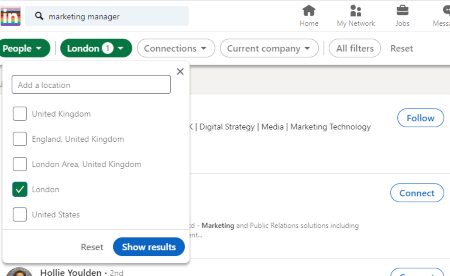The Ultimate Guide to LinkedIn Marketing
In today’s competitive business landscape, finding clients on LinkedIn has become a crucial strategy for professionals and businesses looking to expand their network and increase revenue.
Did you know that 4 out of 5 people on LinkedIn influence business decisions?
The platform is more than just a professional network, it is a business marketplace with nearly a billion users globally. Job seekers can find employment opportunities. Businesses can find leads. Startups can find investors.
People are now more actively engaging with each other since travel restrictions have made it harder to meet in person. In just the last year LinkedIn saw a 55% increase in conversations among connections. The timing is just perfect if you’re looking to take your marketing efforts to the platform. This article will go over 10 effective tips on how to find clients on LinkedIn.
Related: 10 Powerful customer acquisition strategies
How to get clients on LinkedIn
1. Create a buyer persona
A buyer persona is a detailed description of your most ideal client. When you have a clear image of them, you’ll be able to take advantage of LinkedIn’s advanced targeting options to easily find them. LinkedIn allows you to search for people based on their location, job title, and even companies they work for.
A buyer persona will help you get a better understanding of your target audience, which then allows you to create marketing messages that are appealing to them.
For example, if your buyer persona is a 35-year-old man who lives in New York and works in HR, you can create a laser-focused campaign with his image in mind. Your language and tone of voice will be tailored specifically for him. You’ll even be able to estimate what time he’s likely to be found online based on his time zone.
Buyer personas are the starting point of successful marketing campaigns. Check out this article to learn how to easily create one for your business in 5 simple steps.
2. Optimize Your LinkedIn Profile for Finding Clients
Your LinkedIn profile is a representation of your brand. It should give people confidence in whatever it is that you’re selling. Take some time to refine it and make it reassuring to prospective clients.
Your summary should emphasize your strengths and experiences. Add every relevant qualification and experience you have that will help give a boost to your credibility.
Reach out to connections who you’ve worked with in the past to ask for endorsements on your skills. Endorsements add social proof to your profile.
Whenever prospects visit your LinkedIn profile, which they’re probably going to do once you start doing cold outreaches, they should have no question about your competence and credibility.
3. Master the art of the cold outreach on LinkedIn
Cold approach can be nerve-wracking if you’re new to it, but it is an essential part of finding clients on LinkedIn. It’s important to build relationships in order to find success on the platform.
Start by compiling a list consisting of your potential clients. If you have a buyer persona, then you can search for users who have their characteristics. For example, if your buyer personas are marketing managers based in London, search for users with the title “marketing manager” and then filter the results by location, and add “London”.

Visit each profile in the results to identify people who your products would be most suitable for, and then add them to your list. Only people who most resemble your buyer persona should make the cut.
The next step will be to send a connection request to each person, accompanied by a short message introducing yourself. Resist the urge to start selling right away. The goal is to gradually build rapport before you can start selling.
Here are 2 examples of connection request messages you can customize and then use.
LinkedIn connection request templates
Template 1:
Hi Debra,
I just came across your LinkedIn profile and noticed that you develop AI software for XYZ Corp. That’s really interesting! I’d love to keep in touch and learn more about your work.
John
**
Template 2:
Hi Mark,
I recently read your post about XXXX and it resonated with me, so I thought I’d connect to keep in touch and maybe share some ideas at some point in the near future!
All the best!
John
**
Make sure to personalize your LinkedIn connection request messages by using the person’s name and mentioning something they’ve actually done. Impersonal messages that just start with just a “hi” or “hello there” look like lazy efforts by spammers.
Whenever somebody accepts your request, thank them for accepting, and then ask an open-ended question based on their profile.
You can ask about their work experience or current projects they’re working on. The goal is to get them to open up, or at the very least respond to you, without coming off like you’re trying to sell them something.
If they respond to your open-ended question, then perfect. Carry on the conversation naturally to warm them up even further. Be patient and wait for the right moment before you can mention what you do and how you could potentially even help them.
If they don’t respond to your question within 3 days, then they probably have no intention of responding. That’s when you can then take the “do or die” approach and send your pitch as a last resort, just to get your message across.
Focus on how your products or services can help them overcome realistic challenges they’re facing (based on information from your buyer persona).
And if they don’t respond to your pitch, wait at least a week before you can follow up one last time. Marketers often say that you should follow up 4-5 times before giving up, but doing that will only get you to their blacklist. You’ll only be annoying them more than anything.
Some people won’t respond simply because they don’t need your products or services right away. But who knows, their circumstances might change in the future, so don’t burn your bridges by doing endless follow-ups. That’s not how you build relationships.
Related: The ultimate digital marketing guide for startups and small businesses
4. Start asking for referrals
Make it a habit to always ask for referrals from your LinkedIn connections. For instance, if you pitch your products to a new connection, however they’re not interested, don’t waste time trying to persuade them, ask for a referral instead.
You can ask for referrals from your previous clients, colleagues, employers, and even group members. Every time you finish working with a client, ask for a referral. It takes very little effort.
Many people will happily refer you if they like you. Be kind to everyone, always offer to help whenever you can, congratulate them on achievements and anniversaries, send personalized birthday messages, write meaningful comments on their posts.
When people have a good impression of you, they’ll go out of their way to help you, which brings us to the next point…
5. Offer to help for free
It’s easier to win over your new leads when you have their trust. The best way to do that is by offering a helping hand with no expectation of payment. Make it clear that you’re doing it for free and don’t expect anything in return. Your help can be in the form of advice or consultation.
In social psychology, the principle of reciprocity says that people are wired to respond to a positive action with another positive action. That means people who you help are more likely to give you referrals or even become paying clients.
In business, it’s a rule that has been proven countless times. For example, people who have received gifts from a company are more likely to buy from that company in the future. Or, people are more likely to purchase a product or service after receiving an unexpected discount or complementary item.
In life, people will always remember how you treat them and they will return the favor. If you help them, they will likely help you.
6. Build your profile to increase your social proof
Having many friends or a large following on LinkedIn can give a boost to your social proof. It gives the impression that you’re an authority in your field.
Whenever you meet new people, whether in your personal or professional life, send them a LinkedIn connection request. Remember that it’s not always about selling all the time. Be genuinely interested in making new friends and learning from other people, whether they’re potential clients or not.
How to get more followers on LinkedIn
There are many ways to get followers on LinkedIn. Here are some ideas:
- Write engaging and thought-provoking posts. Include images and videos to make them more shareable
- Publish helpful articles
- Comment on other people’s posts
- Join relevant groups and be an active member to familiarize people with your name
- Send connection requests to people you meet everywhere
7. Publish articles to increase your authority
Publishing valuable content is a great way to demonstrate your expertise, increase your authority, and gain more visibility and followers within your target market.
You can write articles on any trendy and in-demand topics which are relevant to your industry. Avoid writing posts for the sole purpose of self-promotion. You can mention your business in a line or two, but it should not be the main focus. LinkedIn posts that provide value are more likely to generate traffic and get better engagement rates.
If you’re not particularly good at writing, you can easily outsource the task to a freelancer on platforms like Upwork and Fiverr, and then provide the guidelines on what to write about.
When people have confidence in your credibility as an expert in your field, converting them into clients becomes significantly easier.
8. Run an ads campaign
LinkedIn is one of the most effective platforms for running PPC ad campaigns. The majority of its users are business decision-makers with twice the buying power of the average internet user.
PPC, or pay per click, is a digital advertising model where ads get served to people as they browse online, however you only get charged for the clicks as an advertiser. For instance, if your ad gets served to 1,000 people, but only 50 people click them, then you’ll only pay for the 50 clicks (despite getting your branding in front of 1,000 people).
LinkedIn Ads has over 200 targeting options to help you pinpoint your buyer persona and ensure that your ads reach them. For instance, you can target people based on their age, location, gender, field of study, schools attended, job title, years of experience, etc.
If you have a detailed buyer persona, then a PPC campaign might be the easiest way to get clients on LinkedIn – given you have the budget for it.
9. Join LinkedIn groups
LinkedIn groups are fantastic sources of potential clients for your business. You can find numerous niche groups where your buyer personas are likely to be found.
For example, if your buyer persona is a business owner, search for “entrepreneurship” or “small business owners” to find relevant groups.
Make sure to introduce yourself every time you join a new group. In just a few lines, say who you are, what you do, and then offer yourself to anyone that needs help. Doing that will help get you off to a good start and give the group members a positive impression of you.
Be an active member by frequently participating in discussions, answering questions, and even asking your own questions. When people keep seeing your name, they start to develop some familiarity to it.
Don’t focus on selling, but on providing value. Every now and then you’ll get an opportunity to pitch your products or services, such as when somebody asks a question that’s directly related to it. But you have to patiently wait for such moments rather than aggressively advertising non-stop.
10. Stay in touch with your leads
Always stay in touch with your leads, even if they’re not yet ready to convert. If you let them go too long without hearing from you, then they’ll probably go cold. All the work you would have put in to get to their attention will count for nothing.
You can stay in touch by congratulating them on any new milestones in their lives such as job promotions, by sending birthday messages or even commenting on their posts.
If you haven’t spoken in a long time, you can send a message just to say “hope you’re doing well”, or share a resource you stumbled upon that they might find useful in their endeavors. Staying in touch keeps you fresh in people’s memory.
Conclusion – Why LinkedIn is Essential for Finding Clients
It is a sad but true fact that in today’s business world, LinkedIn is an under-utilized tool. Because of its association with job seekers, a lot of people tend to ignore the power of LinkedIn as a great platform for marketing , especially when it comes to business to business (B2B) marketing.
The following are some of the reasons why LinkedIn is a great marketing platform for B2B businesses:
1. You can find high quality leads on LinkedIn
LinkedIn has an excellent search engine which allows you to find leads from a very wide range of industries and different roles, down to the level of specific titles. For example, if you are looking for IT Directors from the retail industry in New York City, all this is possible with a few clicks.
2. You can communicate directly with your leads on LinkedIn .
If you find a prospect that interests you, one of the best advantages of using LinkedIn as a platform is that you can establish direct contact via InMail (which allows you to send messages, even those with attachments, to people with whom you are not directly connected).
3. LinkedIn allows you to communicate with your prospects on their terms .
LinkedIn can send your messages directly to the Inbox of your prospects. This is a great way to avoid spam filters, which are increasingly common on email accounts these days.



